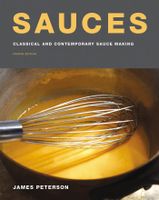Advertisement
Gelatin
Appears in
Published 1991
As meats and fish cook, they release juices that contain gelatin, a water-soluble protein. Depending on the cooking method, these juices end up in the roasting pan or the sauté pan or, in the case of poaching and braising, they are released into the surrounding liquid. When the gelatin is sufficiently concentrated, it gives the cooking liquid a natural, lightly syrupy consistency.
The natural gelatinous consistency that is so appealing in sauces and braising liquids can be achieved in several ways. The most obvious and expensive is to continually reuse meat or fish stocks as moisteners for more meat or fish until the gelatin (and flavor) is so concentrated that the stock has a natural consistency of its own. The resulting liquid is a natural, unthickened demi-glace. Home cooks and professionals have long added strips of pork skin, veal feet, veal knuckles, or chicken or turkey wing tips to stews and stocks to contribute additional natural gelatin. Restaurant chefs often combine these methods with careful reduction to eliminate liquid and concentrate the natural gelatin. In a restaurant setting, natural gelatin is most often added to sauces at the last minute in the form of meat glaze (glace de viande) or fish glaze (glace de poisson). These glazes not only give a finished sauce the natural texture that results from careful reduction but also provide a complex flavor backdrop to offset more assertive components, such as wine or herbs, that are added to give the sauce its final character.

